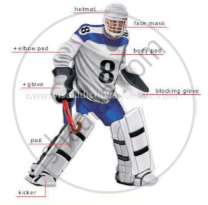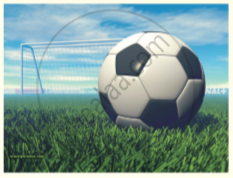Advertisements
Advertisements
प्रश्न
Multiple Choice Question:
According to the passage the home is a ________
विकल्प
house
loving family
furniture
building
उत्तर
According to the passage, the home is a loving family.
APPEARS IN
संबंधित प्रश्न
Answer the question in two or three paragraphs (100–150 words).
How does Evelyn hear music?
Based on your reading of the story, answer the following question by choosing the correct option:
Harold had defied the laws of heredity by
Present Perfect Continuous
Read the following sentences with the present perfect continuous tense
form
1. Mr and Mrs Singh have been living in the same house in the same town
for the last five years.
2. "Have you beenkeepingyourpocketmoneysafely, Rani?"
These sentences illustrate the main use of the Present Perfect Continuous
tense to show that the action started in the past and is still in progress in
the present.
Form pairs - one student will read the text for 'Hockey', and the second student will read the text for 'Football'.
Hockey

The game starts when the umpire blows his whistle for the opening pass-back. The passback is made at the centre of the field to start the game (also after half- time and after each goal is scored). The ball, which may be pushed or hit, must not be directed over the centre line. All players of the opposing team must stand at least 5 yard from the ball and all players of both teams, other than the player making the pass-back must be in their own half of the field.
There are two umpires to control the game and to administer the rules. These umpires are the sole judges of the game. The umpires are responsible for keeping time for the duration of the game.


In front of each goal is an area known as the penalty area. This is a rectangular area, 40.2m wide and extending 16. Sm into the field where the goalkeeper operates.
A standard adult football match consists of two periods of 45 minutes each, known as halves. Each half runs continuously, meaning that the clock is not stopped when the ball is out of play. There is usually a 15-minute half-time break between halves. The end of the match is known as full-time. Anytime during the match, a team can substitute upto three players maximum.
The game is controlled by a referee who is the official timekeeper for the match, and may make an allowance for time lost through substitutions, injured players requiring attention, or other stoppages. There are also two linesmen who keep guard of the touchlines or sidelines, signalling when the ball crosses the boundary lines. The referee alone signals the end of the match.
Handling the ball deliberately, pushing or tripping an opponent, or hitting a player from behind are examples of fouls, punishable by a direct free kick or penalty kick depending on where the offence occurred. Other fouls are punishable by an indirect free kick.
The referee may punish a player's or substitute's misconduct by a caution (yellow card) or sending-off (red card). A player is given a yellow card is said to have been 'booked'.
• Red - Serious misconduct resulting in ejection from the game. If a player has been sent off, no substitute can be brought in his place.
What does he plant who plants a tree?
He plants cool shade and tender rain,
And seed and bud of days to be,
And years that fade and flush again;
He plants the glory of the plain;
He plants the forest's heritage;
The harvest of a coming age;
The joy that unborn eyes shall see___
These things he plants who plants a tree.
Read the lines given above and answer the question that follow:
What is meant by the ‘forest’s heritage’?
The horse was nearly life-size, moulded out of clay, baked, burnt, and brightly coloured, and reared its head proudly, prancing its forelegs in the air and flourishing its tail in a loop; beside the horse stood a warrior with scythelike mustachios, bulging eyes, and aquiline nose. The old image-makers believed in indicating a man of strength by bulging out his eyes and sharpening his moustache tips, and also decorated the man’s chest with beads which looked today like blobs of mud through the ravages of sun and wind and rain (when it came), but Muni would insist that he had known the beads to sparkle like the nine gems at one time in his life.
Read the extract given below and answer the question that follow.
Why had the image makers given the warrior bulging eyes and aquiline nose?
When there was a strong wind, the pine trees made sad, eerie sounds that kept most people to the main road. But Mr. Oliver was not a nervous or imaginative man. He carried a torch – and on the night I write of, its pale gleam, the batteries were running down – moved fitfully over the narrow forest path. When its flickering light fell on the figure of a boy, who was sitting alone on a rock, Mr. Oliver stopped.
Boys were not supposed to be out of school after seven P.M. and it was now well past nine. What are you doing out here, boy, asked Mr. Oliver sharply, moving closer so that he could recognize the miscreant.
Read the extract given below and answer the question that follow.
Whom did Mr Oliver meet in the forest?
“He liked to tease and play”. Who is teasing whom? How?
Who did go alongwith the king to meet the hermit?
Give some examples of fuel.
Why was the monkey happy/unhappy?
“But mother says that kind is good…” What is mother referring to?
Look at these sentences.
1. “Too boring,” he said.
2. Cleaned his room, did his chores.
When we speak, we often leave out words that can easily be guessed. We do not do this when we write unless we are trying to write as we speak (as in the story).
So, if we were to write carefully, we would say:
- “Homework is too boring,” he said.
- He cleaned his room and did his chores.
How did Patrick get supernatural help? Was the elf intelligent enough to answer questions in all the subjects?
Why did the Dog decide to lose his freedom?
Mark the right item:
“This, said the emperor, was to encourage all children to honour and obey their parents.”
‘This’ refers to ______
Multiple Choice Question:
When is beauty heard?
Put these sentences from the story in the right order and write them out in a paragraph. Don’t
refer to the text.
-
I shall be so glad when today is over.
-
Having a leg tied up and hopping about on a crutch is almost fun, I guess.
-
I don’t think I’ll mind being deaf for a day — at least not much.
-
But being blind is so frightening.
-
Only you must tell me about things.
-
Let’s go for a little walk.
-
The other bad days can’t be half as bad as this.
Does Nishad agree with Maya about Mr Nath? How does he feel about him?
Analyse the comparison between death and sleep in the poem, Death Be Not Proud. How does this metaphor contribute to the overall message of the sonnet? Write your answer in about 200-250 words.
